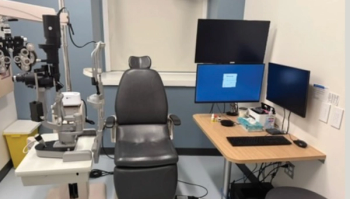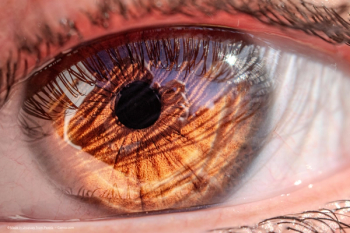
- Ophthalmology Times Europe May 2020
- Volume 16
- Issue 4
Pearls for conducting GATT in open-angle glaucoma
Gonioscopy-assisted transluminal trabeculotomy (GATT) has been shown to be successful in the management of both primary and secondary open-angle glaucoma. Patient selection and management of expectations is key.
By Dr Yasmine M. El Sayed
Gonioscopy-assisted transluminal trabeculotomy (GATT) is an ab interno, minimally invasive glaucoma surgery introduced by Dr Ronald Fellman in 2014.1 It aims to circumferentially incise the inner wall of Schlemm’s canal (SC), in order to connect it directly to the anterior chamber.
The procedure is performed through two clear corneal incisions, under gonioscopic view. An illuminated microcatheter or a prolene suture is introduced into SC through a goniotomy incision and threaded using 23 g microsurgical forceps, coursing circumferentially throughout the entire canal, until it reappears from the opposite cut end of SC. Both ends are then pulled out, creating a 360° incision, cleaving the entire trabecular meshwork (Figure 1).
GATT has been shown to be successful in the management of both primary and secondary open-angle glaucoma, particularly in steroid-induced glaucoma.2 It has also demonstrated effectiveness in paediatric glaucoma and in eyes with a history of previous incisional procedures, including trabeculectomy and glaucoma drainage devices.3
Like most angle-based procedures, GATT requires the surgeon to be familiar with intraoperative gonioscopy and angle structures. These can be practised in a wetlab and/or intraoperatively after phacoemulsification.
Once the surgeon is comfortable with goniosurgery, the procedure itself has a moderate learning curve. Once mastered, it becomes a safe and cost-effective surgical option to lower intraocular pressure (IOP), as well reduce dependence on glaucoma-lowering medications.
GATT carries several advantages:
- It is minimally invasive – performed through two corneal paracentesis – and does not involve leaving a device inside the eye.
- It addresses the juxtacanalicular outflow pathway, known to have the highest resistance to aqueous outflow, thus restoring flow through the eye’s natural drainage system, rather than creating an alternative pathway into the subconjunctival space.
- It does not violate the conjunctiva; hence, it does not compromise the results of any future bleb-based glaucoma surgeries. It also avoids the risks associated with bleb-based procedures, e.g., hypotony, infection and dysthesia.
- The 360° incision directs flow into more collector channels, especially through the inferonasal quadrant, which is known to have a higher distribution of collector channels.4
- It is a low-cost procedure, as it can be performed using a prolene suture.
Patient selection
As with any surgical procedure, proper patient selection is key to success. Patients with a bleeding tendency, corneal opacities that impede proper visualisation of the angle, and eyes with narrow angles are poor candidates for GATT.
GATT may be avoided in poorly compliant patients with advanced glaucoma, where a trabeculectomy or tube surgery may have a better chance of putting the patient off medications.
Managing expectations
GATT is expected to lower the IOP by around 30–50%,5 and the number of glaucoma-lowering medications by one to two. There is some evidence that it is more effective in secondary compared with primary open-angle glaucoma.
A patient on single or a combination therapy may go off treatment after the surgery, but patients on more glaucoma medications will likely need to continue using some of their drops. So, if the patient needs to go off treatment because of side effects or adherence issues, trabeculectomy may be a more appropriate option.
Although GATT is a minimally invasive procedure, one of its main drawbacks is the postoperative hyphema, which is quite common and can be agonising to the patient. I make sure patients understand that the blurring of vision may last for one or more weeks, that in the meantime they should assume a semi-sitting position during most of the day to help absorb the blood, and that there is a chance they may need an additional procedure to wash it out.Intraoperative tips
GATT can be performed through either a temporal or superior approach. We prefer sitting temporally as it allows for easier, more comfortable positioning of the patient’s head towards the nasal side, rather than in a chin-down position.
The patient’s head, gonio lens and the surgical microscope should be positioned in perfect alignment. Fine tune the positioning until you optimise the angle view. Circumferential incisions are easiest to achieve with 6/0 prolene sutures, as the suture passage is less likely to become interrupted. However, because of their smaller calibre. they may be less effective in IOP lowering.
By contrast, 5/0 prolene tends to stop around 270° away from the original goniotomy incision but, unlike 6/0 prolene and illuminated microcatheters, they can be pulled on if their path gets obstructed, thus tearing up the inner wall of SC without having to cut down over the interrupted end.
Cost is another consideration when choosing between suture and microcatheter-assisted GATT, with the use of a suture being considerably cheaper. When using a suture, surgeons should use a hand-held cautery to blunt out the tip, creating as small a knob as possible to avoid it from getting obstructed in SC.
The suture around the limbus should be placed circumferentially and a marker or the cautery used to mark the distance from its tip that corresponds to the circumference of the cornea. This helps to track the suture externally and predict its location if it stops proceeding.
The suture/microcatheter is inserted through a tangential paracentesis pointing towards the site of the goniotomy incision. One should avoid any limbal blood vessels when creating the paracenteses, as bleeding will impede visualisation by mixing with the Goniosol under the gonio lens.
Healon is used to fill the anterior chamber. Healon GV is the best gadget to tamponade blood. Operating with the patient in reverse Trendlenberg position also helps minimise the bleeding in eyes with excessive blood reflux from the angle.
In cases where SC cannot be easily located, such as in eyes with hypopigmented trabeculum or paediatric glaucoma, establishing temporary hypotony by allowing some aqueous to come out of the paracentesis may help to delineate the canal with the blood refluxing from the distal outflow channels.
A 1–2 mm goniotomy incision is created by a 23 g microvitreoretinal (MVR) blade. The posterior lip of the incision is pushed down to visualise and gain access into the canal and I often inject Healon into one side of the canal before cannulating it.
The suture/microcatheter often stops after passing through three quadrants (Figure 2), so if you are performing GATT through a temporal approach, insert the suture through the left end of the goniotomy incision when operating on the right eye and vice versa. This way, if it stops after 270°, you can locate it in the inferior quadrant, which is more accessible than superiorly.
It is important to make sure the anterior chamber is well pressurised throughout the procedure, and after the incision is created circumferentially. Before washing out the Healon, we place the surgical bed into Fowler’s position, with the head tilted at 45–90°. Between 10 and 50% of the Healon should be left at the end of the procedure to tamponade the blood, stopping short of getting blood reflux from the angle.
Surgeons need to be ready with a back-up procedure in case GATT could not be performed intraoperatively. The most common culprit is excessive intraoperative bleeding. Back-up procedures include Kahook dual blade goniotomy, trabectome and ab-externo trabeculotomy. These can still be performed through two sites, on two-opposite quadrants, creating a more-or-less circumferential incision.
Postoperative course
As the filtration is still dependent on the drainage angle, there is still a chance of the patient developing an early steroid response. We only use a combination of antibiotic-steroid ointment at night and a NSAID eye drop for 2–3 weeks.
Patients need to keep their head titled at 30° until the hyphema resolves. In case the hyphema lasts for more than 1 week and is covering the pupillary area, you may inject air intracamerally on the slit lamp.
I find this useful since it moves blood away from the pupillary area, improving vision, and it helps the hyphema to settle and absorb. I have a low threshold to aspirate the hyphema, i.e., if it persists for more than 2–3 weeks, and even earlier for one-eyed patients if it is covering the pupil.
Barriers to success
Although SC surgery is a promising alternative to the relatively more invasive bleb-based procedures, some barriers to success remain to be addressed. The first is the risk of scarring.
Histopathological evidence suggests that, after incising the inner wall of SC, the trabecular meshwork undergoes a repair process, starting in the corneoscleral meshwork, followed by the endothelial and uveal meshwork. It is not yet clear which cases are more likely to scar. Factors such as ethnicity, type of glaucoma, lens status, and size and extent of the incision may influence the postoperative scarring of SC and remain to be studied.
Developing drugs that can be injected intracamerally to halt the healing process may revolutionise the outcome of angle surgery, just as adjunctive antimetabolites have improved the success of trabeculectomy.
Another barrier to success is the health and patency of collector channels. Studies have shown that around one third of the resistance to outflow lies distal to the inner wall of SC. This resistance is even higher in advanced disease.
In cases where the collector channels cannot carry aqueous to the episcleral veins, a bleb-based procedure such as trabeculectomy or glaucoma drainage device implantation may be the only suitable option. Evaluation of this conventional outflow system is still evolving and may soon help us predict which cases are most suited for angle-based procedures.
Disclosures:
YASMINE M. EL SAYED, MD, MRCSED
E: [email protected]
Dr El Sayed is a glaucoma and cataract consultant professor of ophthalmology at Cairo University, Egypt. She has no financial disclosures.
References
1. Grover DS, Godfrey DG, Smith O, Feuer WJ, Montes de Oca I, Fellman RL. Gonioscopy-assisted transluminal trabeculotomy, ab interno trabeculotomy: technique report and preliminary results. Ophthalmology. 2014;121(4):855- 861.
2. Grover DS, Smith O, Fellman RL, Godfrey DG, Gupta A, Montes de Oca I, Feuer WJ. Gonioscopy-assisted transluminal trabeculotomy: an ab interno circumferential trabeculotomy: 24 months follow-up. J Glaucoma. 2018;27(5):393-401.
3. Grover DS, Godfrey DG, Smith O, Shi W, Feuer WJ, Fellman RL. outcomes of gonioscopy-assisted transluminal trabeculotomy (GATT) in eyes with prior incisional glaucoma surgery. J Glaucoma. 2017;26(1):41-45.
4. Elhusseiny AM, El Sayed YM, El Sheikh RH, Gawdat GI, Elhilali HM. Circumferential schlemm’s canal surgery in adult and pediatric glaucoma. Curr Eye Res. 2019;44(12):1281-1290
5. Guo CY, Qi XH, Qi JM. Systematic review and meta-analysis of treating open angle glaucoma with gonioscopy-assisted transluminal trabeculotomy. Int J Ophthalmol. 2020;13(2):317-324
Articles in this issue
over 5 years ago
Online ophthalmic learning in anterior segment surgeryNewsletter
Get the essential updates shaping the future of pharma manufacturing and compliance—subscribe today to Pharmaceutical Technology and never miss a breakthrough.












































